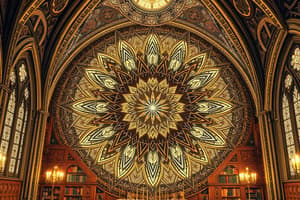Podcast
Questions and Answers
What is formed when a plane intersects a cone at an angle greater than the vertex angle?
What is formed when a plane intersects a cone at an angle greater than the vertex angle?
- Hyperbola
- Circle
- Ellipse (correct)
- Parabola
What shape results when a plane intersects the cone perpendicularly to the axis?
What shape results when a plane intersects the cone perpendicularly to the axis?
- Hyperbola
- Circle (correct)
- Ellipse
- Parabola
Which term describes the rotating line that generates a cone?
Which term describes the rotating line that generates a cone?
- Axis
- Directrix
- Vertex
- Generator (correct)
What type of conic section is created when the angle between the plane and vertical axis is equal to the vertex angle?
What type of conic section is created when the angle between the plane and vertical axis is equal to the vertex angle?
What is the result of a plane intersecting both naps of the cone at an angle less than the vertex angle?
What is the result of a plane intersecting both naps of the cone at an angle less than the vertex angle?
In the context of conic sections, what happens to an ellipse if it intersects at the vertex of the cone?
In the context of conic sections, what happens to an ellipse if it intersects at the vertex of the cone?
What is the name of the lateral surface of the cone?
What is the name of the lateral surface of the cone?
What is characterized by a plane intersecting only one nap of the cone at an angle greater than or equal to the vertex angle?
What is characterized by a plane intersecting only one nap of the cone at an angle greater than or equal to the vertex angle?
Flashcards are hidden until you start studying
Study Notes
Conic Sections Overview
- A double right circular cone consists of two cones joined at a vertex, created when a straight line rotates around a fixed point.
- The rotating line is called the generator, while the fixed line is the axis.
- The cone’s base is circular and the axis is perpendicular to the base, extending to the vertex.
- The perimeter of the base is known as the directrix, and the lateral surface of the cone is referred to as the nap.
- There are two naps: the upper nap and the lower nap, located above and below the vertex, respectively.
- The angle between the generator and the axis is termed the vertex angle.
Types of Conic Sections
-
Ellipse:
- Formed when a plane intersects the cone at an angle greater than the vertex angle, creating a closed curve.
- When the plane is perpendicular to the axis, the ellipse becomes a circle, a specific type of ellipse.
-
Parabola:
- Occurs when the angle between the plane and the vertical axis is exactly equal to the vertex angle, resulting in an open curve.
-
Hyperbola:
- Created when the plane intersects only one nap of the cone with an angle greater than or equal to the vertex angle.
- When the angle is less than the vertex angle, the plane intersects both naps, forming two disjoint curves.
Degenerate Conics
- When a plane intersects the cone at its vertex, the shapes formed are called degenerate conics:
- An ellipse becomes a single point.
- A parabola becomes a line.
- A hyperbola results in two intersecting lines.
Summary of Conic Section Formation
- An angle greater than the vertex angle yields an ellipse.
- A perpendicular angle to the axis transforms an ellipse into a circle.
- An angle equal to the vertex angle forms a parabola.
- An angle less than the vertex angle creates a hyperbola.
- Intersecting the cone at the vertex produces degenerate figures.
Conic Sections Overview
- A double right circular cone consists of two cones joined at a vertex; formed by rotating a straight line (generator) around a fixed point (axis).
- The base of the cone is circular, and the perpendicular axis extends to the vertex, defining its shape.
- The term "directrix" refers to the perimeter of the base, while the lateral surface is known as the nap.
- The cone has two naps: the upper nap above the vertex and the lower nap below it.
- The vertex angle is the angle formed between the generator and the axis of the cone.
Types of Conic Sections
- Ellipse:
- Formed when a plane intersects the cone at an angle greater than the vertex angle, creating a closed curve.
- A special case occurs when the plane is perpendicular to the axis, resulting in a circle, which is a specific type of ellipse.
- Parabola:
- Created when the plane intersects at an angle equal to the vertex angle, resulting in an open curve.
- Hyperbola:
- Occurs when a plane intersects only one nap of the cone at an angle greater than or equal to the vertex angle.
- If the angle is less than the vertex angle, the plane intersects both naps, producing two separate curves.
Degenerate Conics
- Degenerate conics are formed when a plane intersects the cone directly at its vertex:
- An ellipse becomes a single point.
- A parabola transforms into a straight line.
- A hyperbola results in two intersecting lines.
Summary of Conic Section Formation
- Angles greater than the vertex angle produce ellipses.
- A plane perpendicular to the axis converts an ellipse into a circle.
- An angle equal to the vertex angle yields a parabola.
- Angles less than the vertex angle generate hyperbolas.
- Intersecting the cone at its vertex results in degenerate figures.
Studying That Suits You
Use AI to generate personalized quizzes and flashcards to suit your learning preferences.




